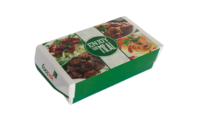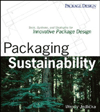Fast change for fast food?

A number of key market drivers are reshaping the food packaging industry. For agile businesses able to respond to these changes, there is tremendous opportunity to thrive within this new, sustainable landscape.
Much of the transformation is being driven by the customer. According to the USDA, there has been a distinct decline in the number of people eating at home since the 1970s, which has been matched by an increase in those eating out of the home or on the move.
As this trend continues, consumers are also showing a greater preference for sustainably sourced food products and packaging. Research released earlier this year by Asia Pulp & Paper Group (APP) found that nearly two-thirds (62%) of Americans say there needs to be more environmentally friendly packaging for food products, with 46 percent of people indicating that they actively seek out food packaged with reusable and recyclable materials. These findings provide valuable insight into one of the most developed paper and packaging markets in the world, while offering a glimpse into the future of broader industry trends for other regions.
Not only are consumer-eating preferences changing, but so are their food shopping habits. “On-the-go” consumption is gathering pace globally, and brands are looking for new ways to improve within the sector to remain competitive. In October 2014, Starbucks introduced Mobile Order and Pay in the Portland area, to allow customers to place orders in advance of their visit with pickup at a selected Starbucks location. For other brands that are looking to implement similar, pre-prepared systems for their own products, packaging will play a critical role in assuring prolonged heat retention capacity, clear display labelling for easy collection, and carry-friendly design.
New Policies for Sustainable Packaging
Legislators are also leading the pressure for change. In the U.S., 2014 marked a major turning point for disposable food packaging as the city of Washington D.C. announced a ban on single-use disposable polystyrene food or drink containers, set to take effect in 2016. Such moves can also be seen in New York City where the mayor, Bill de Blasio, has also announced a ban on polystyrene foam at the beginning of this year that will come into effect as early as July. These two cities follow in the footsteps of San Francisco, who banned its use back in 2006.
Along with the many politicians taking an interest in sustainable food packaging, APP found that many consumers feel similarly, finding that 38 percent of Americans actively seek out restaurants that embrace sustainability practices throughout their operations.
Packaging Manufacturers Develop Innovative, Sustainable Designs
In response to changing market conditions and the push for sustainable packaging, the industry has created a number of innovations. For example, Wisconsin-based packaging designer and manufacturer Placon announced its new recyclable plastic food packaging trays and lids called Envisions. The product is not only sustainable, being made from Placon’s EcoStar® post-consumer, recycled, curbside-collected, PET bottles and thermoforms, but it also offers a supportive and functional design. As a result, consumers are guaranteed an easy-to-carry package that also prevents the food from sliding around inside while on the go. As a result, the product will always remain in top condition while traveling.
Additionally, Canadian-based packaging company Cascades launched its environmentally-conscious, food packaging line last summer. Respak is both recyclable and compostable, as it is made from 50 percent recyclable fibers, leading to a 50 percent reduction in environmental impact compared to the commonly used polycoated cardboard.
Adapting to Environmental Demand Will Bring Success
Being on the cutting edge of innovation in the food service packaging market is critical for brands, to keep pace with emerging trends and enable the industry to continue to become more sustainable. Catering to the increasingly environmentally-conscious consumer who also likes to live on the go, while also staying ahead of new government legislation, is a challenge that is faced by all brands. However, by addressing these challenges with innovations in design and materials, brands will be able to differentiate themselves and build long-term success that keeps both profits and the planet in mind.
Looking for a reprint of this article?
From high-res PDFs to custom plaques, order your copy today!










